The Final Event: Session: Window to EOSC-Nordic and EOSC-Nordic for data repositories
The Knowledge Hub
Supporting the uptake of EOSC in the Nordic and Baltic countries, Minna Lappalainen, CSC, and Anne Sofie Fink, DeiC
Minna Lappalainen explained that one of the challenges faced by EOSC-Nordic is that not many stakeholders know about its existence and its role. Among the challenges, she pointed out that a majority of stakeholders do not know about EOSC or do not have a clear idea about its benefits. Lastly, it is not always clear to them how to engage with EOSC.
To overcome these challenges and offer a tailored-made informative platform, the team has created the EOSC-Nordic Knowledge Hub, aiming at attracting new stakeholders in the region. It is, in essence, a window into the EOSC-Nordic project.
The EOSC-Nordic Knowledge Hub is a customer-oriented service site for different stakeholders who can benefit from EOSC-Nordic: a channel that brings value and produces successful user experiences, by offering targeted information about the services and knowledge that the EOSC environment offers to each type of stakeholder.
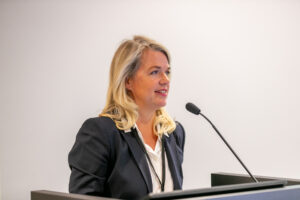
Image: Minna Lappalainen. Photo by Gertrud Alatare.
Anne Sofie Fink explained the user-friendly structure of the EOSC-Nordic Knowledge Hub, which is organised into six different sections:
- materials, in which users can find reports from the project.
- users and organisations: in this section, visitors can find the benefits of EOSC for each stakeholder group, together with engaging case studies showcasing what has been done in the past.
- a training library, in which users can find training opportunities and information about upcoming events.
- the EOSC services; an entry point to access services and guidance for service providers. It shows how to register services under the platform.
- a support section, with FAQs and a link to Service Desk.
- EOSC community, which encourages users to engage with other members and partners, showcasing engagement possibilities.
EOSC-Nordic is confident that this tailored approach can inspire new user-friendly ways of sharing competencies and knowledge to support the EOSC and EOSC-related projects and initiatives in the future.
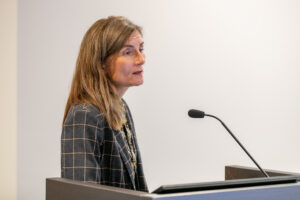
Image: Anne Sofie Fink. Photo by Gertrud Alatare.
The presentation available in the Knowledge Hub
EOSC-Nordic for data repositories
FAIR maturity of Nordic and Baltic research data repositories, Mari Kleemola, Tampere University/FSD
The next session was focused on analysing the maturity of the FAIR implementation in the Nordic and Baltic research data repositories, led by Mari Kleemola, from the Tampere University/FSD.
The implementation of the FAIR data practices is one of the key pillars of EOSC, but what does it stand for? In fact, FAIR means findable, accessible, interoperable and reusable research. Although the usage of FAIR data practices by scientist and researchers is key for the creation of reliable Open data systems, it seems that it is not widely used by this community in the Nordic and Baltics region. According to a survey conducted to track the FAIR uptake in the region, there is a slight increase in the overall average FAIR scores in repositories. During her presentation, Mari Kleemola confirmed that the increase of the FAIR scores can be seen especially in individual repositories. However, the average level of implementation in the region is still low, which indicates that there is room for improvement.
The survey also showed that repositories that run on established platforms (such as Dataverse, Figshare, and others) have noticeably higher FAIR scores. On the other hand, CoreTrustSeal-certified repositories have somewhat higher FAIR scores. But for most repositories, the FAIR score stayed unchanged during the project period.
Considering these results, it is important to analyse how the EOSC is promoting the implementation of FAIR data practices.
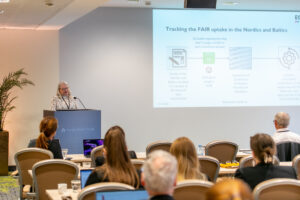
Image: Mari Kleemola. Photo by Gertrud Alatare.
The presentation available in the Knowledge Hub
Successful support for TDR certification and FAIRification – Tuomas J. Alaterä, Tampere University/FSD
To achieve the goal of FAIR digital objects living in trustworthy digital repositories, the project has provided support on FAIRification and CoreTrustSeal certification. Based on invitations and interest, 13 repositories participated in the support program. The project provided webinars, online 1-to-1 support meetings and detailed feedback on CoreTrustSeal self-assessments. We saw clear improvement in the FAIR scores of the supported repositories and we expect that number of CoreTrustSeal-certified repositories will go from 10 to 16 as a result of the project. Sustained efforts to coordinate national, regional and international initiatives and funding would be essential, and the Nordic and Baltic repositories are participating in the ongoing effort to build a European network of FAIR-enabling Trustworthy Digital Repositories (https://doi.org/10.5281/zenodo.7034315).
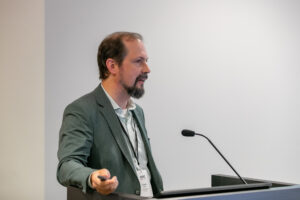
Image: Tuomas J. Alaterä. Photo by Gertrud Alatare.
The presentation available in the Knowledge Hub
Case study on FAIRification and certification: QsarDB – Sulev Sild, Institute of Chemistry, University of Tartu
Sulev Sild, from the Institute of Chemistry at the University of Tartu, instead introduced the QSAR DataBase, a FAIR repository of (Q)SAR/QSPR models for citing and predicting. He explained the results of their FAIRification and certification model which has proven the usefulness of EOSC-Nordic collaboration: “Our metadata was already in good state, but its machine readability was a problem. The hardest part was to configure and modify DSpace to make the metadata machine-readable”, explained.
He confirmed that the collaboration with EOC-Nordic was valuable and productive for them, as “with some help and small development effort” the team working on the QSAR DataBase managed to “significantly improve” the FAIR maturity level of the repository.
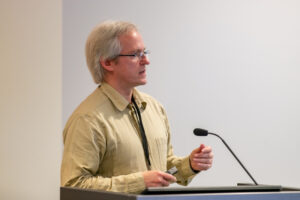
Image: Sulev Sild. Photo by Gertrud Alatare.
The presentation available in the Knowledge Hub
Outcomes of FAIR incentives study and expected impact, Josefine Nordling, CSC
On another note, Josefine Nordling, from CSC, talked about the workaround FAIR incentives that they did and the expected impact that this incentives system might have on the research community.
As she explained, their ambition in working on FAIR incentives was the following: encouraging researchers to comply with FAIR data practices in their research, demonstrating them clear benefits as well as showcasing existing incentives in place for FAIR compliance. The ultimate goal of the team was to reach policy harmonisation in the area.
With these goals in mind, the team gathered inputs from the community thanks to a tailored mapping exercise, literature review and a qualitative study.
Through the interviews with the research community, it was confirmed that the first step to incentivise FAIR implementation was to raise awareness about the FAIR data practise itself, which was not commonly known by many stakeholders. Taking into account a heterogeneous stakeholder environment, the team came up with a model with different levels of interventions that would lead, ultimately, to culture change.
The system established a model of progressive levels, meaning that higher levels could be only achieved when the lower levels are met. Via this “step-by-step” system, the team trusts the FAIR data practise would become more accessible and easier to apply.
The seven levels proposed were the following: offer additional resources for data curation and sharing; have sustainable infrastructure; improve research support services and offer training; develop data sharing metrics and systems based on merits; develop clear requirements for data sharing and FAIR compliance; foster cultural change towards FAIR research; communicate best practices.
At the end of her presentation, Josefine Nordling remarked that the FAIR uptake will have impact in the areas of organisational FAIR data policies; machine-actionable DMPs; properly funded RDM; and monitoring mechanisms for FAIR research.
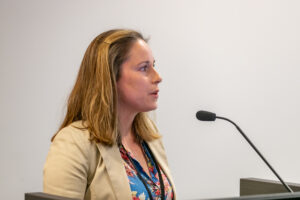
Image: Josefine Nordling. Photo by Gertrud Alatare.
The presentation available in the Knowledge Hub
Case study: M4M for climate community, Hamish Struthers, Linköping University, Sweden
The last case study was presented by Hamish Struthers, from the Linköping University in Sweden. Hamish Struthers reflected on the organisation of two workshops on FAIR data M4M and FIP with a focus on the climate community.
He explained that, theoretically, the climate community has a good understanding of FAIR principles. However, the struggle comes in implementing these principles, in an easy and accessible way. To overcome this challenge, they organise two workshops. The first was focused on Metadata for machines (M4M) workshop (December 2021). The aim was to explore the opportunity to learn the principles of machine-readable metadata and gain practical experience on climate-relevant examples/use cases. The second workshop was on the FAIR Implementation Profiles (FIP), in which they showcased a collection of machine-readable FAIR implementation choices for each of the FAIR Principles. These profiles can be used to optimise the reuse of existing FAIR Enabling Resources.
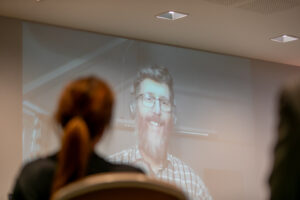
Image: Hamish Struthers. Photo by Gertrud Alatare.